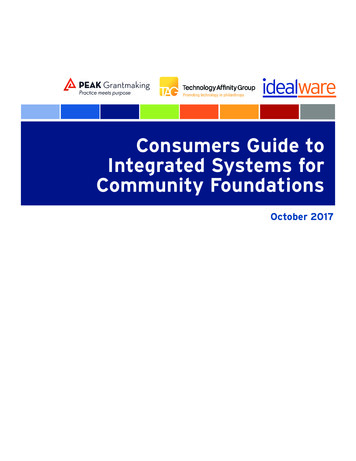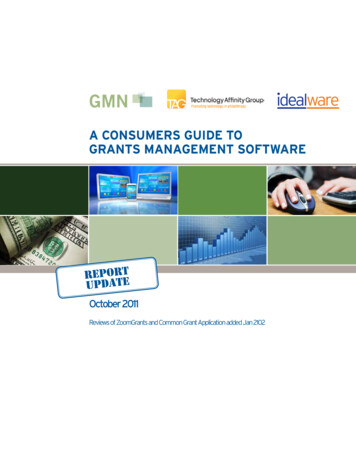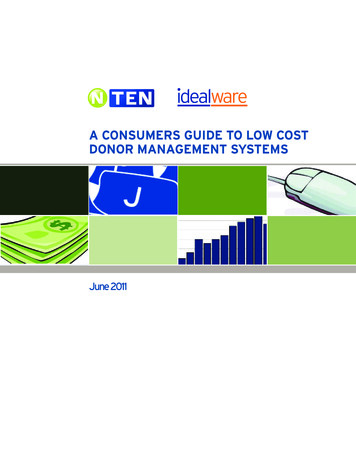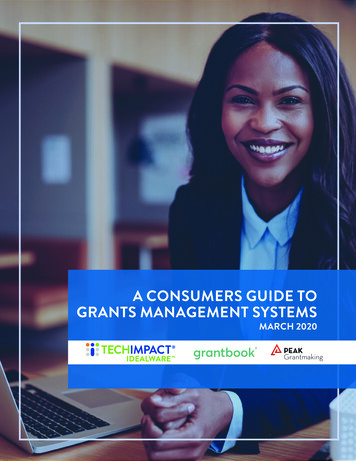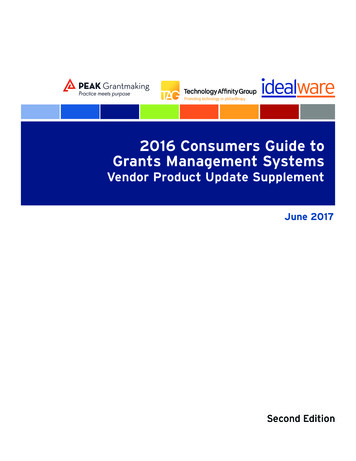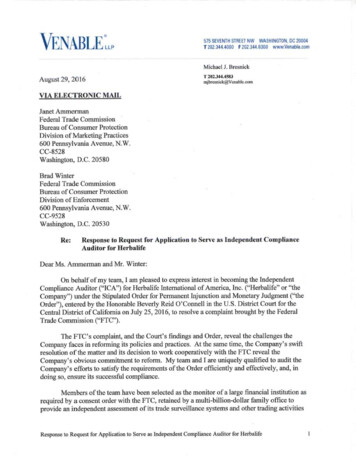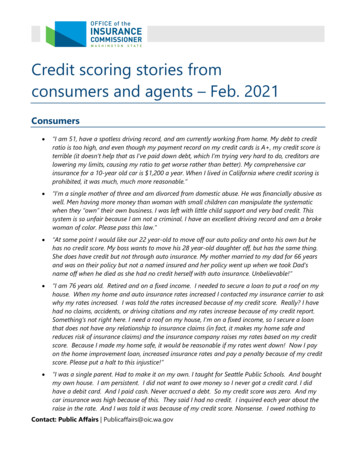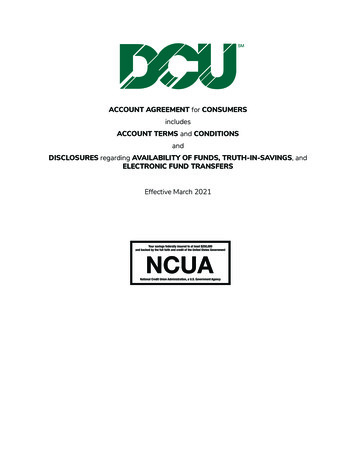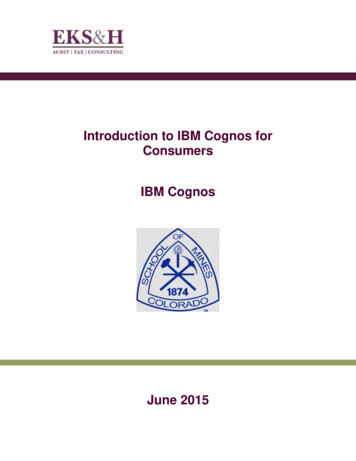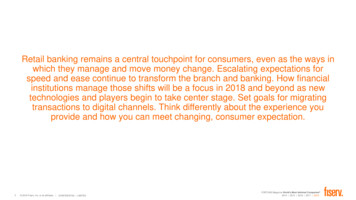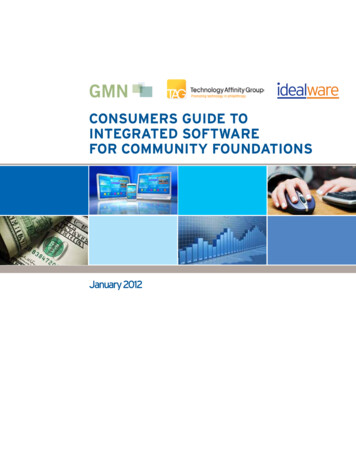
Transcription
Consumers Guide toIntegrated Softwarefor Community FoundationsJanuary 2012
AuthorsJay Leslie, IdealwareKyle Andrei, IdealwareLaura Quinn, IdealwareChris Bernard, IdealwareAcknowledgementsMany thanks to the organizations who supported this researchThe Grants Managers NetworkThe William and Flora Hewlett FoundationThe Charles Stewart Mott FoundationThe Technology Affinity GroupAnd to the experts who contributed their timeJoseph Behaylo, Open Society FoundationsJim Bickel, The Cleveland FoundationIgnacio Estrada, Gordon and Betty Moore FoundationArt Frank, Oregon Community FoundationJonathan Goldberg, Surdna FoundationRichard Myers, Consultant to the Foundation for the CarolinasAmy Pollien, The Maine Community FoundationLisa Pool, Technology Affinity GroupMartin Schneiderman, Information Age AssociatesRebecca Van Sickle, The Atlantic PhilanthropiesPAGE2Consumers Guide to Integrated Software for Community Foundations January 2012
ContentsExecutive Summary.4Considering Community Foundation Solutions . .6Introduction.7Do You Need a Community Foundation Solution?.8What Do Community Foundation Solutions Do?.9How Do The Systems Compare?.17Comparison Chart. 19How to Decide. 20Reviews of Community Foundation Solutions. 22Bromelkamp Community Pearl.23ChesterCAP Dotche. 29Fusion Labs GrantedGE. 35MicroEdge FIMS. 41Stellar Technology Solutions iPhi. 47Appendices.53Appendix A: Research Methodology. 54Appendix B: How We Evaluated the Systems. 55About the Report Partners. 63PAGE3Consumers Guide to Integrated Software for Community Foundations January 2012
Executive SummaryCommunity foundations have a complex set ofrequirements to track their data. In addition tomaking grants, a typical community foundation alsosolicits donations, manages investments and acts asfiscal custodian for funds under advisement fromdonors, and awards scholarships. In a real way, eachcommunity foundation is a grantmaker, fundraiserand financial institution all at once.There’s a limited list of vendors who provide solutions for these particular needs—only five met ourrequirements for this report to qualify as solutionsappropriate for community foundations. By necessity,these vendors provide more than just standaloneFive vendors provideintegrated ecosystemsintended to support allaspects of communityfoundations’ work.grants management systems. Rather, they provideintegrated ecosystems intended to support all aspectsof community foundations’ work. Most of thesystems we reviewed met this complex set of needsby integrating an ensemble cast of software—sometimes from different vendors—into a comprehensivesolution.We evaluated each system by 137 criteria geared todetermine how well it stacked up to the criteria mostimportant to community foundations. The reportprovides more detailed summaries, a comparisonchart and extensive reviews of the five systems foreach of the 137 criteria. In general, how do the available packages compare?PAGE4Bromelkamp Community PearlBromelkamp provides a fully integrated, installed solutionbuilt in Microsoft Access. The grants management side ofthe system uses the same functionality as Bromelkamp’sFirst Pearl, with the same strengths in internal tracking,online grant applications and reviews, and payments andbudgeting. The system has strong functionality for printedcommunications, but is weak in broadcast email. Community Pearl adds full community foundation-specificfunctionality in a highly integrated system with no needto navigate between multiple modules. It provides reasonable functionality to track incoming gifts, a donor portal, afull accounting system and surprisingly powerful functionality to manage fund details and investment income. Theentire system is built in Microsoft Access, which is botha strength and a weakness. On one hand, Pearl leveragesAccess’s solid report builder and uses its inherent flexibility to tailor Community Pearl to each client’s needs,including adding fields or features to support uniqueprocesses. On the other, Access has limitations in userinterface design options, which manifests in sometimescrowded screens, abbreviated labels and heavy reliance oncodes that can be daunting for the uninitiated.ChesterCAP DotcheChesterCAP’s Dotche provides a central hub to knit asuite of third party components into a hosted softwaresolution for community foundations. Dotche itselfspecializes in online transactions—it provides strongsupport for online applications (including a streamlinedscholarship application module), application review anda donor portal. Donation tracking functionality is quiteweak, however—for instance, it’s not possible to tracka pledge in the system—as is both printed and emailedcorrespondence. The system is built to integrate withother solutions to manage relationships, payments and accounting. The vendor demonstrated the system integratedwith SunGard’s Addvantage to provide reasonably solidsupport for accounting, fund management and budgeting,and with NetSuite to provide much of the solution’s support for relationship management, while also augmentingDotche’s reporting facility. Addvantage and NetSuiteConsumers Guide to Integrated Software for Community Foundations January 2012
are each robust solutions in their own right that providesubstantial value to ChesterCAP’s implementation, andwhile there is fairly seamless cross-product data exchangebehind the scenes, the user experience suffers.Fusion Labs GrantedGEGrantedGE is an installed system that adds solid grantsmanagement functionality to a suite of Blackbaud tools:Raiser’s Edge, Financial Edge and Blackbaud Net Community (BBNC). Raiser’s Edge is a widely used and wellrespected donor management system with powerful features to track gifts, relationships and fundraising processes.Financial Edge is also a well-respected accounting systemin its own right. GrantedGE adds mid-level features fortracking grants and scholarships and application review, aswell as tailored Net Community functionality with reasonable support for online applications and a donor portal.With support from the powerful Raiser’s Edge features,the system provides strong features to create mailings,broadcast emails and reports. The systems are tightlyintegrated; data flows between the four systems, and theinterface matches across the different functions, decreasingthe potential confusion of a multi-system setup.MicroEdge FIMSFIMS is a traditional, installed community foundationsolution that allows clients to assemble a tightly integratedsystem through an extensive menu of modules. It’s agenerally solid grants management system with goodsupport for online applications, tracking grants, payments,and both email and printed correspondence. Application review functionality is the exception, however—ithas no ability to score applications or to allow externalreviewers. Relationship management, donation trackingand broadcast emails are somewhat limited in the coresystem, but are augmented by the Salesforce-based FIMSCRM system. This CRM system is accessed online via acompletely different interface than the core FIMS system.Stellar Technology Solutions iPhiSuiteiPhi Suite by Stellar Technology Solutions is a quitepowerful online, hosted system for community foundations. The company made its start with software forfinancial institutions, and this focus shows through robustfunctionality to manage funds, investment income, donorPAGE5portals and payments. It’s also strong in grants management features, such as online applications, due-diligencefunctionality and scholarships. While it’s very good atwhat it supports, and was the most consistently usableand integrated system we reviewed, it has some holes. Itlacks the ability for reviewers to score applications, forinstance, and has almost no functionality to send emailsor create printed correspondence. Reporting is alsosomewhat limited—it’s not possible to name and savecustom reports, for example—and there’s no programmatic access to the data (as through an API). Thoughcomposed of several modules, the interface is polished,consistent and pleasant to use throughout, with functionality and data available seamlessly and easily. Functionalityis well-thought out and generally powerful.Do you needrobust fundraisingfunctionality or strongintegrated broadcastemail? Can you affordthe systems at thehigh end? And howimportant is the userexperience?Which should you use? With just five vendors to choosefrom, it’s tempting to want to explore them all for yourorganization, but their complexity could make that anoverwhelming task. While you’ll certainly want to carefullycompare two or three, you can likely use this report toeliminate at least one or two of the systems. Consider afew questions to help you decide. These systems aren’tcheap—can you afford those at the high end? Do youneed sophisticated fundraising functionality, or strongintegrated broadcast email? And how important is it toprovide your users with a polished and integrated userexperience?Consumers Guide to Integrated Software for Community Foundations January 2012
Considering CommunityFoundation Solutions
IntroductionIn October 2011, Idealware, TAG and the GrantsManagement Network launched a report looking atgrants management systems for private foundations.Why a second report for community foundations?Because community foundations operate quite differently than private foundations, and have a complexset of additional requirements to track their data.In addition to making grants, a typical communityfoundation also solicits donations, manages investments, acts as fiscal custodian for funds underadvisement from donors, and awards scholarships.Community foundationsare essentially grantmakers, fundraisers,and financial institutionsall at once.The experts we spoke to described communityfoundations as grantmakers, fundraisers and financialinstitutions all at once. Each of these roles requiressomething different of a foundation. As grantmakers, community foundations need to track grantapplications, review processes and make payments,like all foundations. But their assets are typicallymade up of dozens, or even hundreds, of different“funds”—money specifically earmarked by the donorfor a particular purpose—each of which can have itsown rules, restrictions and reporting requirements. Ina way, each fund can be viewed as a mini-foundation.As fundraisers, community foundations have the sameneeds as any nonprofit dependent upon gifts—theyneed to be able to understand their relationships withprospects and donors, solicit them by mail and email,PAGE7track complex gifts and grants, and understand whatfund each gift should go toward. They’ll also act asfiscal custodians of individual “donor-advised funds”for major donors who want to commit to ongoingphilanthropy. While the foundation has direct controlover these assets, donors often expect to be able toeasily check balances, view statements, deposit moneyand make grant recommendations for them—oftenonline. To complicate things further, the moneyunder a community foundation’s management is ofteninvested in a variety of investment vehicles, and thefoundation must keep track of how the investmentincome affects each fund under its management.These requirements combine to make accountingparticularly complex, as well. Community foundationsneed to track incoming gifts, outgoing grants andinvestment income for each of potentially hundredsof different funds, and to be able to see the balanceof each more or less in real time. This feature makesdata integration across the organization particularlydesirable. If a foundation were to separate systems forfundraising, grants management and fund accounting,integrating all the data for real-time fund balanceswould be extremely difficult.With a small number of potential customers—thereare only about 700 community foundations in theUnited States—and a complex set of requirements, alimited list of vendors provide solutions that addressthese particular needs. We reviewed 22 different grantsmanagement systems for private foundations, butonly five vendors met our requirements to qualify assolutions appropriate for community foundations forthis report.By necessity, these vendors provide more than juststandalone grants management systems—they provideintegrated ecosystems intended to support all aspectsof community foundations’ work. Most of the systems we reviewed meet this complex set of needs byintegrating an ensemble cast of software—sometimesfrom different vendors—into a single, comprehensivesolution.Consumers Guide to Integrated Software for Community Foundations January 2012
Do You Need a Community FoundationSolution?Many community foundations manage their processeswith a set of multiple, unintegrated products—forexample, a donor management system, a grants management system and a separate accounting system.Does it make sense for such foundations to move to aspecialized community foundation system instead?If streamlined dataaccess between differentareas of functionality isimportant to you, youmay find a systemthat fits your needsin this report.PAGE8The most compelling reasons to switch are the needto tightly integrate data, or to provide more supportfor donor-advised funds.For instance, are you having trouble determining thebalance of particular funds? Do you spend a substantial amount of time trying to get data from one systeminto another, especially for accounting purposes? Aremajor donors asking for online portal functionalitythat you can’t provide—or provide easily—from yourcurrent setup? If you answered yes to any of thesequestions, the five solutions included in this reportcould be worth the investment. They all boast relatively seamless integration between different systems,or modules, to provide comprehensive accountingdata. And all have an integrated donor portal that canprovide fund information in approximate real time.If streamlined data access between different areasof functionality is important to you, you may find asystem that fits your needs among those reviewed inthis report.Consumers Guide to Integrated Software for Community Foundations January 2012
What Do Community FoundationSolutions Do?It’s difficult to think about your own foundation’sneeds or evaluate the systems available to meet themwithout a solid understanding of what features arepossible, and which are common. Based on ourinterviews with foundation staff and reviews ofvarious systems, we learned a few things about what’stypically available in these systems, and about what’sdesirable. More is not always better. The right systemfor your organization is the one that best supportsyour needs, not necessarily the one with the mostfeatures—feature-rich solutions can also be needlesslycomplex, and may present an unnecessarily highlearning curve for your staff.Use this section to construct a list of the features thatmight be useful to you, and then carefully prioritizethe list for your own organization.Fund ManagementThe core of a community foundation’s data management system is the ability to manage multiplefunds—sometimes dozens, or even hundreds, ofthem. Each fund is a pool of money that often comeswith different restrictions. For example, one fundmay be income from a grant that can only be used forspecific purposes, while another might be made up ofdonations from the community for a less-restricted“community building” fund. Many communityfoundations also allow philanthropic individuals tocreate a “donor-advised fund” from which they canthen recommend grants. For each fund, the systemmust track incoming donations, outgoing grants andchanges in income based on investments.The core requirement in fund management is theability to see the balance of any given fund inapproximate real time. This feature is the primarydriver behind the need for integrated systems forcommunity foundations—if a foundation were touse one system for fundraising, another for grantsmanagement and a third for fund accounting, it wouldPAGE9be very difficult to integrate all the data for real-timefund balances.It’s also important that the system be able to trackinformation about each fund. For instance, whatare the restrictions, if any? Are there specific rulesabout how much should be paid out in grants foreach fund, and will the system calculate the suggestedannual payout based on those rules? Are there specificreporting requirements for the fund—for instance,has the donor requested a yearly summary rather thanquarterly updates? It’s also very useful for a grantsmanager to be able to easily look through the fundsThe right system foryou organization isthe one that bestsupports your needs,not necessarily the onewith the most features.and restrictions to find a fund that might match wellwith a grant the foundation would like to make.For many foundations, it’s also important to be ableto manage investment income by creating investment“pools” with money from a variety of funds. As fundassets can be part of many pools—and pools cancontain many funds—straightforward functionalityto associate investment income or losses to fundsis often desirable. All the systems we reviewed willlet you associate funds with one or multiple pools,and allow you to define the proportion of the fundinvested in each pool. Consider how foundation staffConsumers Guide to Integrated Software for Community Foundations January 2012
will update the funds with the income or losses basedon a statement. Is that an easy process?Donor PortalsIt’s often desirable to give donors the ability tomanage their funds online. As banks and investmentfirms move features to the web, many donors expectfoundations to be online as well—and at a minimum,to be able to use an online donor portal to viewtheir current balance and grantmaking history, if notmake a deposit or provide information about a grantthey’d like to make. Foundations also frequently findit useful to be able to make a list of “appr
In October 2011, Idealware, TAG and the Grants Management Network launched a report looking at grants management systems for private foundations. Why a second report for community foundations? Because community foundations operate quite differ-ently than private foundations, and have a co
